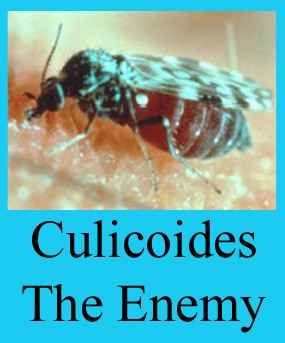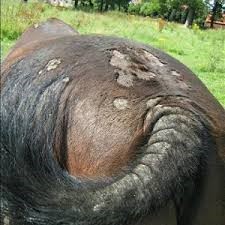Sweet Itch
Sweet itch is a condition caused by a reaction to the saliva of biting midges and usually occurs during the months from April to early November. It causes horses to become intensely pruritic (itchy) resulting in them rubbing their manes, tails and sometimes, but much less commonly their undersides. Shetland Ponies and Icelandic Horses are particularly prone to this condition. However, it can affect any horse. It is the antigens present in the saliva of the Culicoides midge and to a lesser extent, a member of the black fly family called Simulium Equinum that horses are allergic to. There is no cure for sweet itch. It can only be managed, and once a horse has it, they have it for life.
Figure 1: Culicoides (midge) Figure 3 – Horse suffering from sweet itch


Sweet itch varies in severity from horse to horse with some only rubbing occasionally, and with others rubbing themselves completely bald, causing open sores on their mane and rump.
Treatment
Treatment of sweet itch involves fly avoidance techniques, fly repellents, systemic anti-inflammatory therapy and sometimes nutraceuticals.
The mainstay of controlling sweet itch is to try to avoid having your horse bitten by midges. This can be achieved by using a good quality fly repellent such as Deosect. Deosect only needs to be applied once every 14 days, and is thus a very cost effective way of preventing your horse from becoming bitten by flies. Deosect can be purchased from Central Equine Vets. It is a good idea to start using a good quality fly repellent just before the midge season starts, rather than waiting for your horse to start itching. Specific fly rugs e.g. Boett rugs exist which can help cover your horses’ skin and thus prevent the midges from biting. Avoid having your horse graze at dusk and dawn (when midges are most active) and try to make sure that your horse is not grazing near woodlands or standing water e.g. ponds as these are the midges’ favourite spots! Fields which are naturally breezy have much lower midge burdens as the midge cannot fly against a wind greater 5 m.p.h.! If you do stable your horse at dusk and dawn, remember that midges can fly in and out of stables. Having a very fine midge net across your horses’ stable doors can help prevent this. If this is not an option then try a fan in the stable block near the entrance – this helps create a wind, which can mean less midges.
If fly avoidance and fly repellents are not working, then systemic anti-inflammatories need to be used to control the allergic reaction, and hence the itch. Oral steroids work best for this. However, there are some important side effects associated with steroids, which as a horse owner you need to be aware of. Your vet will discuss the pros and cons of steroids prior to administering them. Generally speaking steroids work much better than anti-histamines for the treatment of this condition.
The nutraceutical – Cavalesse works well in some horses. This comes as both a food supplement and a cream. It contains the natural occurring B Vitamin Nicotinamide. It works by preventing the degranulation of mast cells. Degranulating mast cells in the skin surface release histamine, and this causes the horse to itch. It also helps to improve the lipid (fat) barrier in the skin, which makes it harder for the midge saliva to penetrate deep into the skin, thus further helping limit the allergic reaction.
For further information on sweet itch please contact Central Equine Vets on 0131 664 5606.